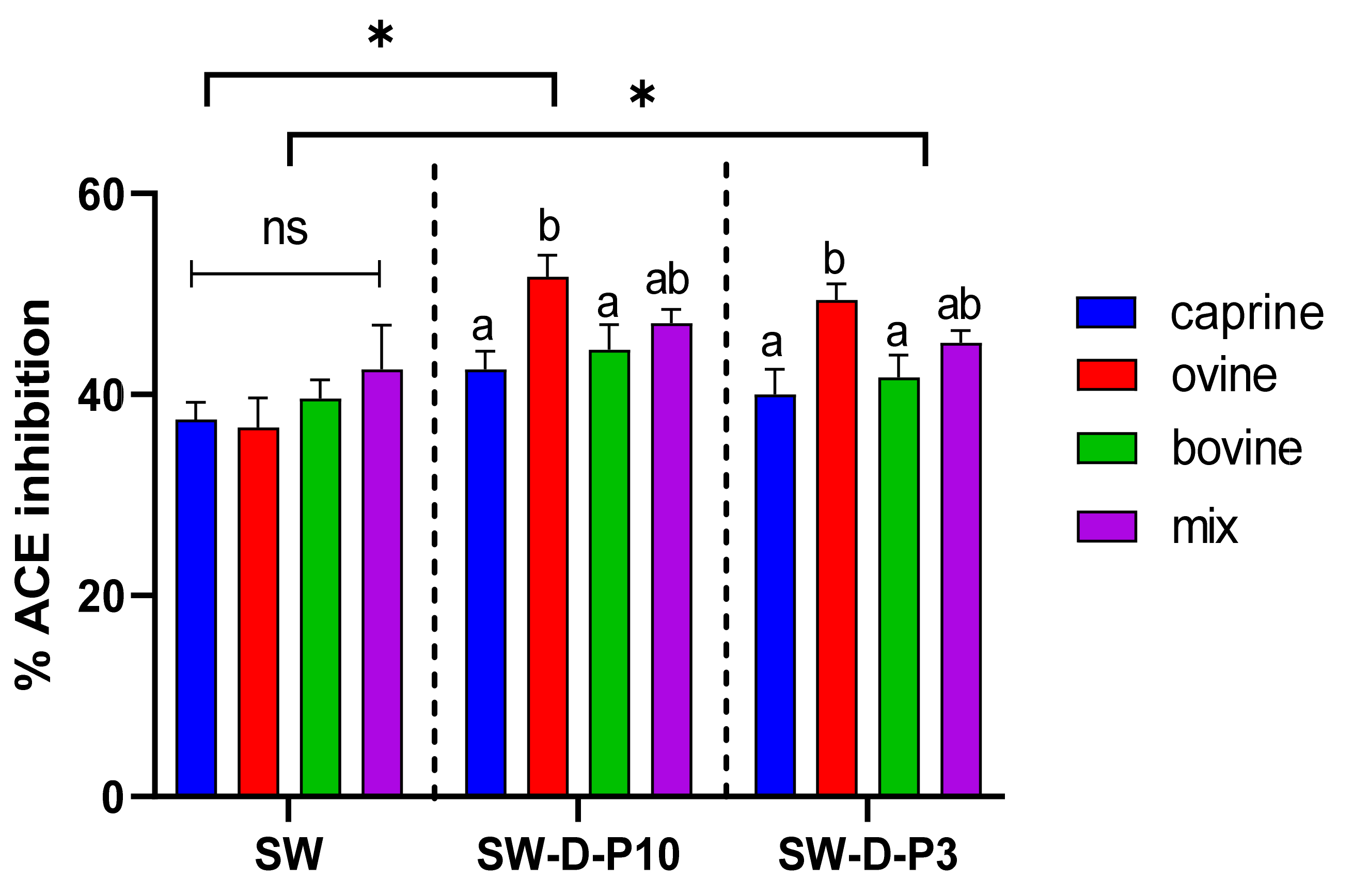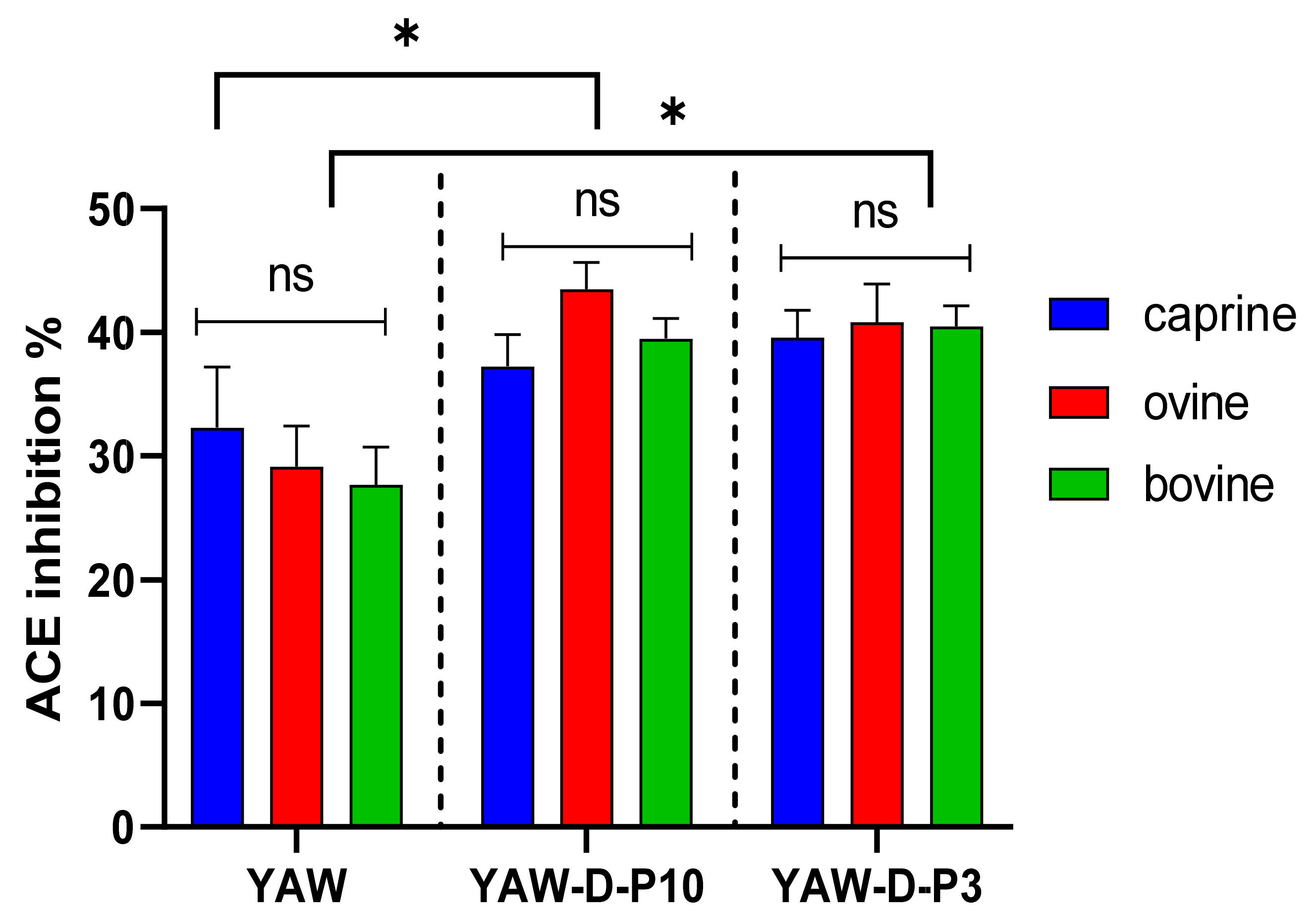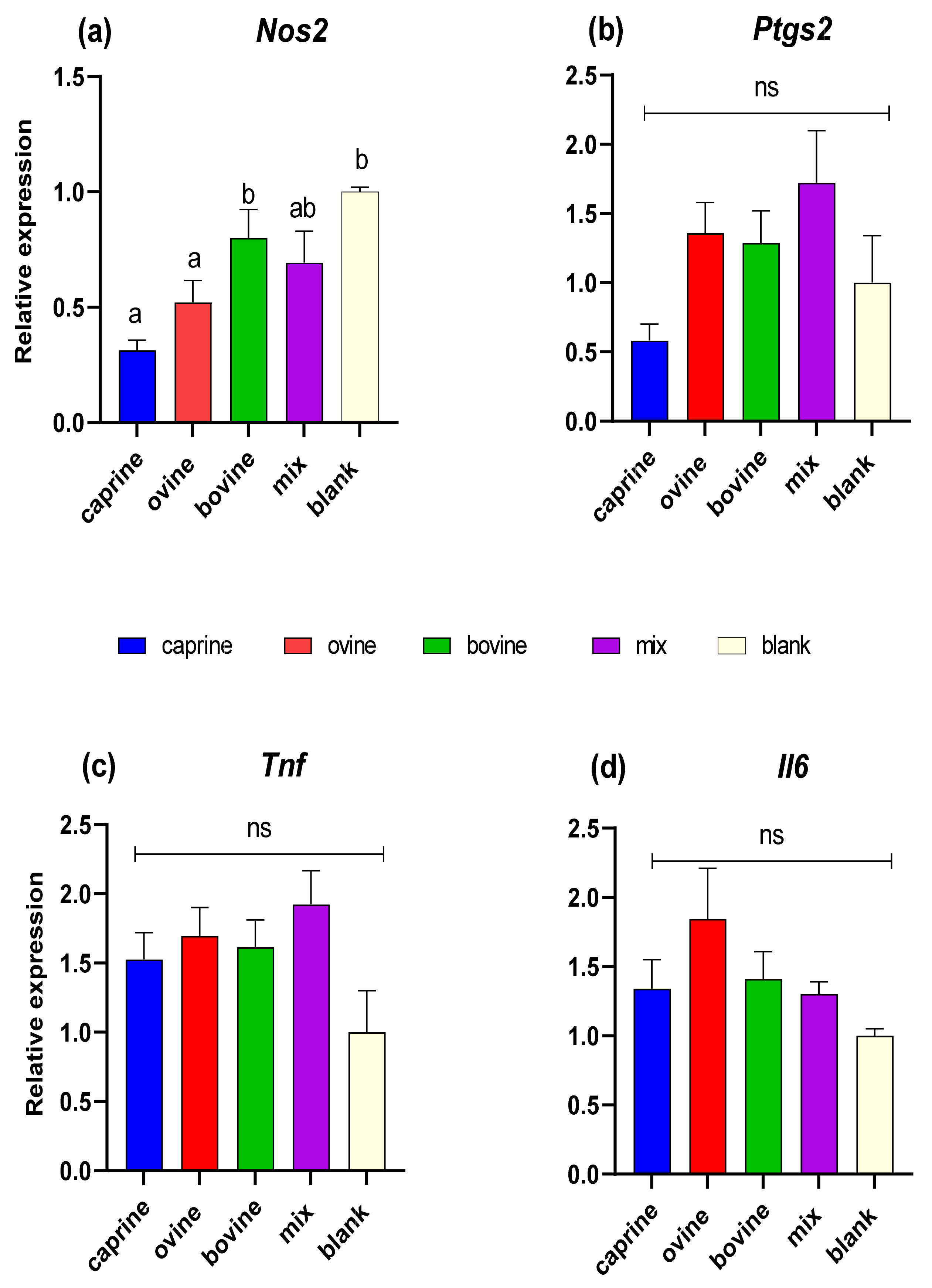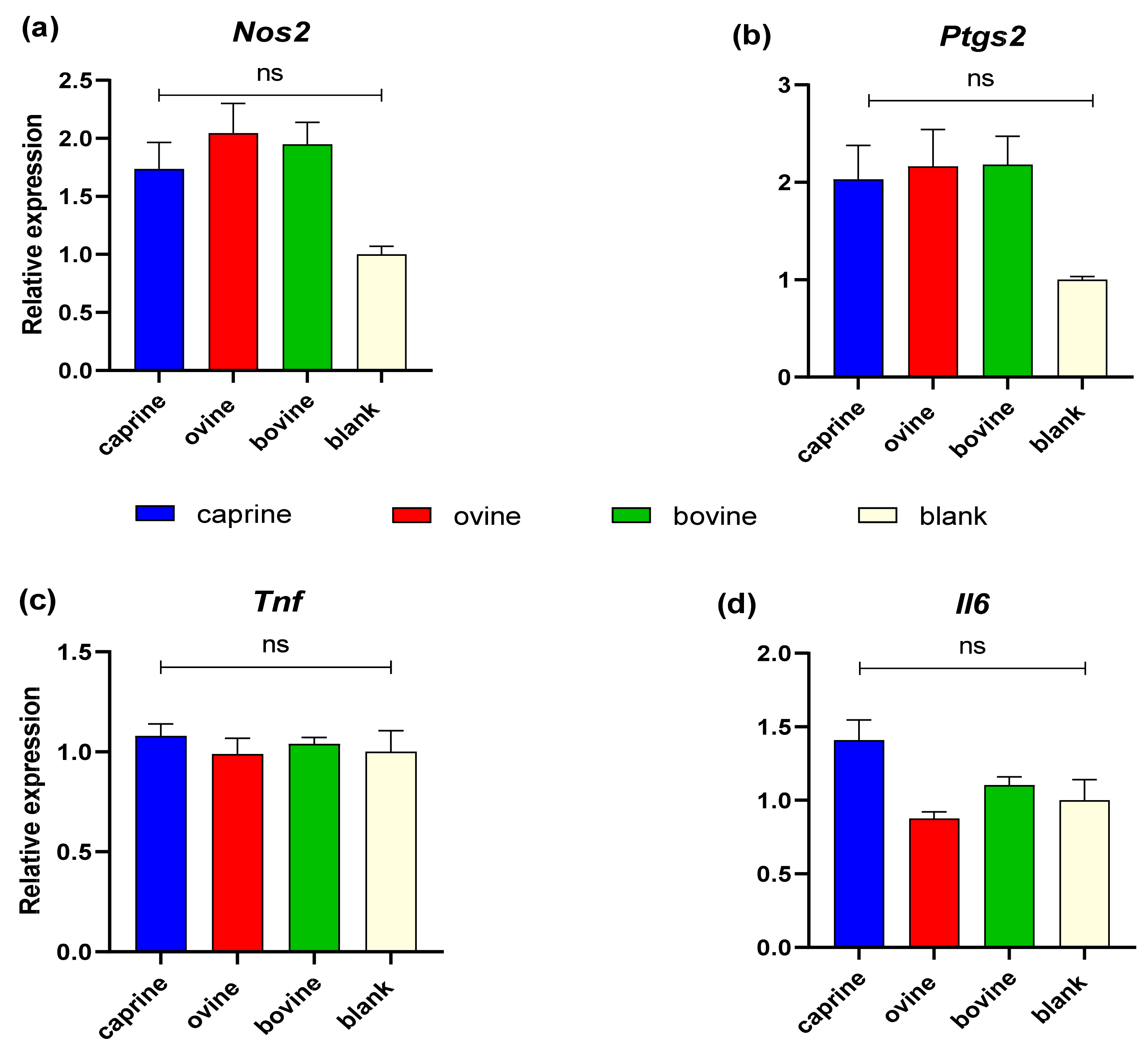Evaluation of In Vitro Antihypertensive and Anti-Inflammatory Properties of Dairy By-Products
Abstract
:1. Introduction
2. Materials and Methods
2.1. Chemicals and Reagents
2.2. Collection and Preparation of Dairy By-Products
2.3. In Vitro Digestion Protocol and Digestate Fractionation
2.4. Measurement of ACE-Inhibitory Activity
2.5. Anti-Inflammatory Properties of Digestates
2.5.1. Cell Culture, Cell Viability, and Activation of RAW 264.7
2.5.2. Determination of Nitric Oxide (NO) Production by LPS-Stimulated Macrophage RAW 264.7 Cells
2.5.3. Quantification of Gene Expression in LPS-Stimulated Macrophage RAW 264.7 Cells
2.6. Statistical Analysis
3. Results and Discussion
3.1. Determination of ACE-Inhibitory Activity of Dairy By-Products
3.2. Effect of D-P3 on Nitric Oxide Production in LPS-Stimulated RAW 264.7 Cells
3.3. Effect of D-P3 on Expression of Inflammation-Related Genes
4. Conclusions
Author Contributions
Funding
Institutional Review Board Statement
Informed Consent Statement
Data Availability Statement
Acknowledgments
Conflicts of Interest
References
- Cardiovascular Diseases (CVDs). Available online: https://www.who.int/en/news-room/fact-sheets/detail/cardiovascular-diseases-(cvds) (accessed on 20 December 2023).
- Lin, L.; Lv, S.; Li, B. Angiotensin-I-Converting Enzyme (ACE)-Inhibitory and Antihypertensive Properties of Squid Skin Gelatin Hydrolysates. Food Chem. 2012, 131, 225–230. [Google Scholar] [CrossRef]
- Chen, L.; Deng, H.; Cui, H.; Fang, J.; Zuo, Z.; Deng, J.; Li, Y.; Wang, X.; Zhao, L. Inflammatory Responses and Inflammation-Associated Diseases in Organs. Oncotarget 2018, 9, 7204. [Google Scholar] [CrossRef] [PubMed]
- Sorriento, D.; Iaccarino, G. Inflammation and Cardiovascular Diseases: The Most Recent Findings. Int. J. Mol. Sci. 2019, 20, 3879. [Google Scholar] [CrossRef] [PubMed]
- Wilson, J.; Hayes, M.; Carney, B. Angiotensin-I-Converting Enzyme and Prolyl Endopeptidase Inhibitory Peptides from Natural Sources with a Focus on Marine Processing by-Products. Food Chem. 2011, 129, 235–244. [Google Scholar] [CrossRef] [PubMed]
- García-Burgos, M.; Moreno-Fernández, J.; Alférez, M.J.M.; Díaz-Castro, J.; López-Aliaga, I. New Perspectives in Fermented Dairy Products and Their Health Relevance. J. Funct. Foods 2020, 72, 104059. [Google Scholar] [CrossRef]
- Carvalho, F.; Prazeres, A.R.; Rivas, J. Cheese Whey Wastewater: Characterization and Treatment. Sci. Total Environ. 2013, 445–446, 385–396. [Google Scholar] [CrossRef] [PubMed]
- Bong, D.D.; Moraru, C.I. Use of Micellar Casein Concentrate for Greek-Style Yogurt Manufacturing: Effects on Processing and Product Properties. J. Dairy Sci. 2014, 97, 1259–1269. [Google Scholar] [CrossRef] [PubMed]
- Dalaka, E.; Stefos, G.C.; Politis, I.; Theodorou, G. Effect of Milk Origin and Seasonality of Yogurt Acid Whey on Antioxidant Activity before and after In Vitro Gastrointestinal Digestion. Antioxidants 2023, 12, 2130. [Google Scholar] [CrossRef]
- Dalaka, E.; Politis, I.; Theodorou, G. Antioxidant Activity of Sweet Whey Derived from Bovine, Ovine and Caprine Milk Obtained from Various Small-Scale Cheese Plants in Greece before and after In Vitro Simulated Gastrointestinal Digestion. Antioxidants 2023, 12, 1676. [Google Scholar] [CrossRef]
- Gauthier, S.F.; Pouliot, Y.; Saint-Sauveur, D. Immunomodulatory Peptides Obtained by the Enzymatic Hydrolysis of Whey Proteins. Int. Dairy J. 2006, 16, 1315–1323. [Google Scholar] [CrossRef]
- Phelan, M.; Khaldi, N.; Shields, D.C.; Kerins, D.M. Angiotensin Converting Enzyme and Nitric Oxide Inhibitory Activities Ofnovel Milk Derived Peptides. Int. Dairy J. 2014, 35, 38–42. [Google Scholar] [CrossRef]
- Pihlanto-Leppälä, A.; Koskinen, P.; Phlola, K.; Tupasela, T.; Korhonen, H. Angiotensin I-Converting Enzyme Inhibitory Properties of Whey Protein Digests: Concentration and Characterization of Active Peptides. J. Dairy Res. 2000, 67, 53–64. [Google Scholar] [CrossRef] [PubMed]
- Guo, Q.; Chen, P.; Chen, X. Bioactive Peptides Derived from Fermented Foods: Preparation and Biological Activities. J. Funct. Foods 2023, 101, 105422. [Google Scholar] [CrossRef]
- Cruz-Casas, D.E.; Aguilar, C.N.; Ascacio-Valdés, J.A.; Rodríguez-Herrera, R.; Chávez-González, M.L.; Flores-Gallegos, A.C. Enzymatic Hydrolysis and Microbial Fermentation: The Most Favorable Biotechnological Methods for the Release of Bioactive Peptides. Food Chem. Mol. Sci. 2021, 3, 2666–5662. [Google Scholar] [CrossRef] [PubMed]
- Li, R.; Zhuang, Y.; Lin, L.; Li, L.; Fan, X.; Sun, L. In Vitro Simulated Gastrointestinal Digestion Stability and in Vivo Antihypertensive Effect of the Peptide KYPHVF and Its Network Pharmacology. J. Funct. Foods 2023, 107, 105672. [Google Scholar] [CrossRef]
- Pihlanto-Leppälä, A. Bioactive Peptides Derived from Bovine Whey Proteins: Opioid and Ace-Inhibitory Peptides. Trends Food Sci. Technol. 2000, 11, 347–356. [Google Scholar] [CrossRef]
- Giromini, C.; Fekete, Á.A.; Ian Givens, D.I.; Baldi, A.; Lovegrove, J.A. Short-Communication: A Comparison of the in Vitro Angiotensin-1-Converting Enzyme Inhibitory Capacity of Dairy and Plant Protein Supplements. Nutrients 2017, 9, 1352. [Google Scholar] [CrossRef]
- Pihlanto-Leppaïa, A.; Rokka, T.; Korhonen, H. Angiotensin I Converting Enzyme Inhibitory Peptides Derived from Bovine Milk Proteins. Int. Dairy J. 1998, 8, 325–331. [Google Scholar] [CrossRef]
- Abdulkhaleq, L.A.; Assi, M.A.; Abdullah, R.; Zamri-Saad, M.; Taufiq-Yap, Y.H.; Hezmee, M.N.M. The Crucial Roles of Inflammatory Mediators in Inflammation: A Review. Vet. World 2018, 11, 627. [Google Scholar] [CrossRef]
- Chang, S.H.; Lin, Y.Y.; Wu, G.J.; Huang, C.H.; Tsai, G.J. Effect of Chitosan Molecular Weight on Anti-Inflammatory Activity in the RAW 264.7 Macrophage Model. Int. J. Biol. Macromol. 2019, 131, 167–175. [Google Scholar] [CrossRef]
- Heo, S.J.; Yoon, W.J.; Kim, K.N.; Ahn, G.N.; Kang, S.M.; Kang, D.H.; Affan, A.; Oh, C.; Jung, W.K.; Jeon, Y.J. Evaluation of Anti-Inflammatory Effect of Fucoxanthin Isolated from Brown Algae in Lipopolysaccharide-Stimulated RAW 264.7 Macrophages. Food Chem. Toxicol. 2010, 48, 2045–2051. [Google Scholar] [CrossRef] [PubMed]
- Senthil Kumar, K.J.; Wang, S.Y. Lucidone Inhibits INOS and COX-2 Expression in LPS-Induced RAW 264.7 Murine Macrophage Cells via NF-KappaB and MAPKs Signaling Pathways. Planta Med. 2009, 75, 494–500. [Google Scholar] [CrossRef] [PubMed]
- Qian, Z.J.; Kim, S.A.; Lee, J.S.; Kim, H.J.; Choi, I.W.; Jung, W.K. The Antioxidant and Anti-Inflammatory Effects of Abalone Intestine Digest, Haliotis Discus Hannai in RAW 264.7 Macrophages. Biotechnol. Bioprocess Eng. 2012, 17, 475–484. [Google Scholar] [CrossRef]
- Brodkorb, A.; Egger, L.; Alminger, M.; Alvito, P.; Assunção, R.; Ballance, S.; Bohn, T.; Bourlieu-Lacanal, C.; Boutrou, R.; Carrière, F.; et al. INFOGEST Static in Vitro Simulation of Gastrointestinal Food Digestion. Nat. Protoc. 2019, 14, 991–1014. [Google Scholar] [CrossRef] [PubMed]
- Minekus, M.; Alminger, M.; Alvito, P.; Ballance, S.; Bohn, T.; Bourlieu, C.; Carrière, F.; Boutrou, R.; Corredig, M.; Dupont, D.; et al. A Standardised Static in Vitro Digestion Method Suitable for Food—An International Consensus. Food Funct. 2014, 5, 1113–1124. [Google Scholar] [CrossRef] [PubMed]
- Shalaby, S.M.; Zakora, M.; Otte, J. Performance of Two Commonly Used Angiotensin-Converting Enzyme Inhibition Assays Using FA-PGG and HHL as Substrates. J. Dairy Res. 2006, 73, 178–186. [Google Scholar] [CrossRef] [PubMed]
- Otte, J.; Shalaby, S.M.; Zakora, M.; Pripp, A.H.; El-Shabrawy, S.A. Angiotensin-Converting Enzyme Inhibitory Activity of Milk Protein Hydrolysates: Effect of Substrate, Enzyme and Time of Hydrolysis. Int. Dairy J. 2007, 17, 488–503. [Google Scholar] [CrossRef]
- Griess, P. Bemerkungen Zu Der Abhandlung Der HH. Weselsky Und Benedikt „Ueber Einige Azoverbindungen”. Berichte Dtsch. Chem. Ges. 1879, 12, 426–428. [Google Scholar] [CrossRef]
- Pinto, R.V.; Antunes, F.; Pires, J.; Silva-Herdade, A.; Pinto, M.L. A Comparison of Different Approaches to Quantify Nitric Oxide Release from NO-Releasing Materials in Relevant Biological Media. Molecules 2020, 25, 2580. [Google Scholar] [CrossRef]
- Hellemans, J.; Mortier, G.; De Paepe, A.; Speleman, F.; Vandesompele, J. QBase Relative Quantification Framework and Software for Management and Automated Analysis of Real-Time Quantitative PCR Data. Genome Biol. 2008, 8, R19. [Google Scholar] [CrossRef]
- Templeton, G.F.; Templeton, G.F. A Two-Step Approach for Transforming Continuous Variables to Normal: Implications and Recommendations for IS Research. Commun. Assoc. Inf. Syst. 2011, 28, 41–58. [Google Scholar] [CrossRef]
- Amigo, L.; Hernández-Ledesma, B. Current Evidence on the Bioavailability of Food Bioactive Peptides. Molecules 2020, 25, 4479. [Google Scholar] [CrossRef] [PubMed]
- Roberts, P.R.; Burney, J.D.; Black, K.W.; Zaloga, G.P. Effect of Chain Length on Absorption of Biologically Active Peptides from the Gastrointestinal Tract. Digestion 1999, 60, 332–337. [Google Scholar] [CrossRef] [PubMed]
- Barac, M.; Vucic, T.; Zilic, S.; Pesic, M.; Sokovic, M.; Petrovic, J.; Kostic, A.; Ignjatovic, I.S.; Milincic, D. The Effect of in Vitro Digestion on Antioxidant, ACE-Inhibitory and Antimicrobial Potentials of Traditional Serbian White-Brined Cheeses. Foods 2019, 8, 94. [Google Scholar] [CrossRef] [PubMed]
- Li, X.; Feng, C.; Hong, H.; Zhang, Y.; Luo, Z.; Wang, Q.; Luo, Y.; Tan, Y. Novel ACE Inhibitory Peptides Derived from Whey Protein Hydrolysates: Identification and Molecular Docking Analysis. Food Biosci. 2022, 48, 101737. [Google Scholar] [CrossRef]
- Giromini, C.; Lovegrove, J.A.; Givens, D.I.; Rebucci, R.; Pinotti, L.; Maffioli, E.; Tedeschi, G.; Sundaram, T.S.; Baldi, A. In Vitro-Digested Milk Proteins: Evaluation of Angiotensin-1-Converting Enzyme Inhibitory and Antioxidant Activities, Peptidomic Profile, and Mucin Gene Expression in HT29-MTX Cells. J. Dairy Sci. 2019, 102, 10760–10771. [Google Scholar] [CrossRef] [PubMed]
- Tavares, T.; Contreras, M.D.M.; Amorim, M.; Pintado, M.; Recio, I.; Malcata, F.X. Novel Whey-Derived Peptides with Inhibitory Effect against Angiotensin-Converting Enzyme: In Vitro Effect and Stability to Gastrointestinal Enzymes. Peptides 2011, 32, 1013–1019. [Google Scholar] [CrossRef] [PubMed]
- Jrad, Z.; El Hatmi, H.; Adt, I.; Girardet, J.-M.; Cakir-Kiefer, C.; Jardin, J.; Degraeve, P.; Khorchani, T.; Oulahal, N.; Jrad, Z.; et al. Effect of Digestive Enzymes on Antimicrobial, Radical Scavenging and Angiotensin I-Converting Enzyme Inhibitory Activities of Camel Colostrum and Milk Proteins. Dairy Sci. Technol. 2014, 94, 205–224. [Google Scholar] [CrossRef]
- Tagliazucchi, D.; Shamsia, S.; Helal, A.; Conte, A. Angiotensin-Converting Enzyme Inhibitory Peptides from Goats’ Milk Released by in Vitro Gastro-Intestinal Digestion. Int. Dairy J. 2017, 71, 6–16. [Google Scholar] [CrossRef]
- Manso, M.A.; López, R.; López-Fandiño, L.; Fandiño, F. Angiotensin I Converting Enzyme-Inhibitory Activity of Bovine, Ovine, and Caprine k-Casein Macropeptides and Their Tryptic Hydrolysates. J. Food Prot. 2003, 66, 1686–1692. [Google Scholar] [CrossRef]
- Vermeirssen, V.; Van Camp, J.; Decroos, K.; Van Wijmelbeke, L.; Verstraete, W. The Impact of Fermentation and in Vitro Digestion on the Formation of Angiotensin-I-Converting Enzyme Inhibitory Activity from Pea and Whey Protein. J. Dairy Sci. 2003, 86, 429–438. [Google Scholar] [CrossRef]
- Abedin, M.M.; Chourasia, R.; Chiring Phukon, L.; Singh, S.P.; Kumar Rai, A. Characterization of ACE Inhibitory and Antioxidant Peptides in Yak and Cow Milk Hard Chhurpi Cheese of the Sikkim Himalayan Region. Food Chem. X 2022, 13, 100231. [Google Scholar] [CrossRef]
- Lignitto, L.; Cavatorta, V.; Balzan, S.; Gabai, G.; Galaverna, G.; Novelli, E.; Sforza, S.; Segato, S. Angiotensin-Converting Enzyme Inhibitory Activity of Water-Soluble Extracts of Asiago d’allevo Cheese. Int. Dairy J. 2010, 20, 11–17. [Google Scholar] [CrossRef]
- Rocha-Mendoza, D.; Kosmerl, E.; Krentz, A.; Zhang, L.; Badiger, S.; Miyagusuku-Cruzado, G.; Mayta-Apaza, A.; Giusti, M.; Jiménez-Flores, R.; García-Cano, I. Invited Review: Acid Whey Trends and Health Benefits. J. Dairy Sci. 2021, 104, 1262–1275. [Google Scholar] [CrossRef]
- Baig, D.; Sabikhi, L.; Khetra, Y.; Kumar, D. Effect of Casein to Fat Ratio of Camel Milk on Solids Losses in Cheese Whey and Their Recovery in Camel Milk Cheese. Int. Dairy J. 2022, 124, 105185. [Google Scholar] [CrossRef]
- Outinen, M.; Heino, A.; Uusi-Rauva, J. Pre-Treatment Methods of Edam Cheese Milk. Effect on the Whey Composition. LWT-Food Sci. Technol. 2010, 43, 647–654. [Google Scholar] [CrossRef]
- Martín-Diana, A.B.; Fraga, M.J.; Fontecha, J. Isolation and Characterisation of Caseinmacropeptide from Bovine, Ovine, and Caprine Cheese Whey. Eur. Food Res. Technol. 2002, 214, 282–286. [Google Scholar] [CrossRef]
- Xia, Y.; Yu, J.; Xu, W.; Shuang, Q. Purification and Characterization of Angiotensin-I-Converting Enzyme Inhibitory Peptides Isolated from Whey Proteins of Milk Fermented with Lactobacillus Plantarum QS670. J. Dairy Sci. 2020, 103, 4919–4928. [Google Scholar] [CrossRef]
- McGrane, M.M.; Essery, E.; Obbagy, J.; Lyon, J.; MacNeil, P.; Spahn, J.; van Horn, L. Dairy Consumption, Blood Pressure, and Risk of Hypertension: An Evidence-Based Review of Recent Literature. Curr. Cardiovasc. Risk Rep. 2011, 5, 287–298. [Google Scholar] [CrossRef]
- Vajdi, M.; Musazadeh, V.; Zareei, M.; Adeli, S.; Karimi, A.; Hojjati, A.; Darzi, M.; Shoorei, H.; Abbasalizad Farhangi, M. The Effects of Whey Protein on Blood Pressure: A Systematic Review and Dose-Response Meta-Analysis of Randomized Controlled Trials. Nutr. Metab. Cardiovasc. Dis. 2023, 33, 1633–1646. [Google Scholar] [CrossRef] [PubMed]
- Xue, L.; Yin, R.; Howell, K.; Zhang, P. Activity and Bioavailability of Food Protein-Derived Angiotensin-I-Converting Enzyme–Inhibitory Peptides. Compr. Rev. Food Sci. Food Saf. 2021, 20, 1150–1187. [Google Scholar] [CrossRef]
- Chung, J.-Y.; Kim, Y.-S.; Kim, Y.; Yoo, S.-H. Regulation of Inflammation by Sucrose Isomer, Turanose, in Raw 264.7 Cells. J. Cancer Prev. 2017, 22, 195. [Google Scholar] [CrossRef] [PubMed]
- Pinho, S.C.M.; Faria, M.A.; Melo, A.; Pinto, E.; Almeida, A.; Alves, R.; Cabrita, A.R.J.; Fonseca, A.J.M.; Ferreira, I.M.P.L.V.O. Effect of Skimmed Milk on Intestinal Tract: Prevention of Increased Reactive Oxygen Species and Nitric Oxide Formation. Int. Dairy J. 2021, 118, 105046. [Google Scholar] [CrossRef]
- Chun, S.H.; Lee, K.W. Immune-Enhancing Effects of β-Lactoglobulin Glycated with Lactose Following in Vitro Digestion on Cyclophosphamide-Induced Immunosuppressed Mice. J. Dairy Sci. 2022, 105, 623–636. [Google Scholar] [CrossRef] [PubMed]
- Zhao, Q.; Li, K.; Jiang, K.; Yuan, Z.; Xiao, M.; Wei, G.; Zheng, W.; Wang, X.; Huang, A. Proteomic Approach-Based Comparison of Metabolic Pathways and Functional Activities of Whey Proteins Derived from Guishan and Saanen Goat Milk. J. Dairy Sci. 2023, 106, 2247–2260. [Google Scholar] [CrossRef] [PubMed]
- Prakash, P.K.; Eligar, S.M.; Prakruthi, M.; Jyothi Lakshmi, A. setty Comparative Assessment of Antioxidant and Immunomodulatory Properties of Skimmed Milk Protein Hydrolysates and Their Incorporation in Beverage Mix. J. Sci. Food Agric. 2022, 102, 6414–6422. [Google Scholar] [CrossRef] [PubMed]
- Kim, D.H.; Chun, S.H.; Oh, N.S.; Lee, J.Y.; Lee, K.W. Anti-Inflammatory Activities of Maillard Reaction Products from Whey Protein Isolate Fermented by Lactobacillus Gasseri 4M13 in Lipopolysaccharide-Stimulated RAW264.7 Cells. J. Dairy Sci. 2019, 102, 7707–7716. [Google Scholar] [CrossRef] [PubMed]
- Dharmisthaben, P.; Sakure, A.; Liu, Z.; Maurya, R.; Das, S.; Basaiawmoit, B.; Kumari, R.; Bishnoi, M.; Kondepudi, K.K.; Gawai, K.M.; et al. Identification and Molecular Mechanisms of Novel Antioxidative Peptides from Fermented Camel Milk (Kachchi Breed, India) with Anti-Inflammatory Activity in Raw Macrophages Cell Lines. Int. J. Dairy Technol. 2023, 76, 111–125. [Google Scholar] [CrossRef]
- De Espindola, J.S.; Ferreira Taccóla, M.; da Silva, V.S.N.; dos Santos, L.D.; Rossini, B.C.; Mendonça, B.C.; Pacheco, M.T.B.; Galland, F. Digestion-Resistant Whey Peptides Promote Antioxidant Effect on Caco-2 Cells. Food Res. Int. 2023, 173, 113291. [Google Scholar] [CrossRef]
- Coleman, J.W. Nitric Oxide in Immunity and Inflammation. Int. Immunopharmacol. 2001, 1, 1397–1406. [Google Scholar] [CrossRef]
- Park, E.; Seo, B.-Y.; Yoon, Y.-C.; Lee, S.-M. Beneficial Effects of Hydrolysates of Whey Proteins in Spontaneously Hypertensive Rats. J. Food Nutr. Res. 2017, 5, 794–800. [Google Scholar] [CrossRef]
- Gandhi, K.; Devi, S.; Gautam, P.B.; Sharma, R.; Mann, B.; Ranvir, S.; Sao, K.; Pandey, V. Enhanced Bioavailability of Iron from Spray Dried Whey Protein Concentrate-Iron (WPC-Fe) Complex in Anaemic and Weaning Conditions. J. Funct. Foods 2019, 58, 275–281. [Google Scholar] [CrossRef]
- Orekhov, A.N.; Orekhova, V.A.; Nikiforov, N.G.; Myasoedova, V.A.; Grechko, A.V.; Romanenko, E.B.; Zhang, D.; Chistiakov, D.A. Monocyte Differentiation and Macrophage Polarization. Vessel Plus 2019, 3, 10. [Google Scholar] [CrossRef]
- Kim, H.S.; Lee, J.H.; Moon, S.H.; Ahn, D.U.; Paik, H.D. Ovalbumin Hydrolysates Inhibit Nitric Oxide Production in LPS-Induced 264.7 Macrophages. Food Sci. Anim. Resour. 2020, 40, 274. [Google Scholar] [CrossRef]
- Olejnik, A.; Kowalska, K.; Olkowicz, M.; Rychlik, J.; Juzwa, W.; Myszka, K.; Dembczyński, R.; Białas, W. Anti-Inflammatory Effects of Gastrointestinal Digested Sambucus Nigra L. Fruit Extract Analysed in Co-Cultured Intestinal Epithelial Cells and Lipopolysaccharide-Stimulated Macrophages. J. Funct. Foods 2015, 19, 649–660. [Google Scholar] [CrossRef]
- Montoya-Rodríguez, A.; de Mejía, E.G.; Dia, V.P.; Reyes-Moreno, C.; Milán-Carrillo, J. Extrusion Improved the Anti-Inflammatory Effect of Amaranth (Amaranthus hypochondriacus) Hydrolysates in LPS-Induced Human THP-1 Macrophage-like and Mouse RAW 264.7 Macrophages by Preventing Activation of NF-ΚB Signaling. Mol. Nutr. Food Res. 2014, 58, 1028–1041. [Google Scholar] [CrossRef] [PubMed]
- Feng, M.; Wang, X.; Xiong, H.; Qiu, T.; Zhang, H.; Guo, F.; Jiang, L.; Sun, Y. Anti-Inflammatory Effects of Three Selenium-Enriched Brown Rice Protein Hydrolysates in LPS-Induced RAW264.7 Macrophages via NF-ΚB/MAPKs Signaling Pathways. J. Funct. Foods 2021, 76, 104320. [Google Scholar] [CrossRef]
- Gao, Y.; Zhang, X.; Ren, G.; Wu, C.; Qin, P.; Yao, Y. Peptides from Extruded Lupin (Lupinus albus L.) Regulate Inflammatory Activity via the P38 MAPK Signal Transduction Pathway in RAW 264.7 Cells. J. Agric. Food Chem. 2020, 68, 11702–11709. [Google Scholar] [CrossRef] [PubMed]
- Zhao, Q.; Zheng, W.; Yuan, Z.; Wang, X.; Huang, A. Anti-Inflammatory Effect of Two Novel Peptides Derived from Binglangjiang Buffalo Whey Protein in Lipopolysaccharide-Stimulated RAW264.7 Macrophages. Food Chem. 2023, 429, 136804. [Google Scholar] [CrossRef] [PubMed]
- Ma, Y.; Liu, J.; Shi, H.; Yu, L.L. Isolation and Characterization of Anti-Inflammatory Peptides Derived from Whey Protein. J. Dairy Sci. 2016, 99, 6902–6912. [Google Scholar] [CrossRef]
- Shukla, P.; Sakure, A.; Basaiawmoit, B.; Khakhariya, R.; Maurya, R.; Bishnoi, M.; Kondepudi, K.K.; Liu, Z.; Padhi, S.; Rai, A.K.; et al. Molecular Binding Mechanism and Novel Antidiabetic and Anti-Hypertensive Bioactive Peptides from Fermented Camel Milk with Anti-Inflammatory Activity in Raw Macrophages Cell Lines. Amino Acids 2023, 55, 1621–1640. [Google Scholar] [CrossRef] [PubMed]
- Bamdad, F.; Shin, S.H.; Suh, J.W.; Nimalaratne, C.; Sunwoo, H. Anti-Inflammatory and Antioxidant Properties of Casein Hydrolysate Produced Using High Hydrostatic Pressure Combined with Proteolytic Enzymes. Molecules 2017, 22, 609. [Google Scholar] [CrossRef] [PubMed]
- O’Sullivan, S.M.; O’Callaghan, Y.C.; O’Keeffe, M.B.; FitzGerald, R.J.; O’Brien, N.M. Immunomodulatory Activity of 5 KDa Permeate Fractions of Casein Hydrolysates Generated Using a Range of Enzymes in Jurkat T Cells and RAW264.7 Macrophages. Int. Dairy J. 2019, 91, 9–17. [Google Scholar] [CrossRef]






| Gene (Accession Number) | Primer Direction | Sequence (5′-3′) | Reaction Efficiency | Amplicon Size |
|---|---|---|---|---|
| Actb (NM_007393.5) | Forward | GAAGATCAAGATCATTGCTCCTC | 95 | 121 |
| Reverse | GGACTCGTCATACTCCTGC | |||
| Cyc1 (NM_007393.5) | Forward | CTAACCCTGAGGCTGCAAGA | 110 | 113 |
| Reverse | GCCAGTGAGCAGGGAAAATA | |||
| Nos2 (NM_001313921.1) | Forward | GGAACATCCCAAATACGAGTG | 110 | 297 |
| Reverse | TTCTGCTTCTGGAAACTATGGA | |||
| Ptgs2 (NM_011198.5) | Forward | CTCAGCCATACAGCAAATCCT | 106 | 299 |
| Reverse | GGACTGTCAATCAAATGTGATCTG | |||
| Tnf (NM_001278601.1) | Forward | CAGATGAAGTGCTCCTTCCAG | 109 | 164 |
| Reverse | CCTCGTTATCCCATGTGTCG | |||
| Il6 (NM_001314054.1) | Forward | CTCTGCAAGAGACTTCCATCC | 91 | 187 |
| Reverse | TCTCATTTCCACGATTTCCCAG |
Disclaimer/Publisher’s Note: The statements, opinions and data contained in all publications are solely those of the individual author(s) and contributor(s) and not of MDPI and/or the editor(s). MDPI and/or the editor(s) disclaim responsibility for any injury to people or property resulting from any ideas, methods, instructions or products referred to in the content. |
© 2024 by the authors. Licensee MDPI, Basel, Switzerland. This article is an open access article distributed under the terms and conditions of the Creative Commons Attribution (CC BY) license (https://creativecommons.org/licenses/by/4.0/).
Share and Cite
Dalaka, E.; Stefos, G.C.; Politis, I.; Theodorou, G. Evaluation of In Vitro Antihypertensive and Anti-Inflammatory Properties of Dairy By-Products. Appl. Sci. 2024, 14, 6885. https://doi.org/10.3390/app14166885
Dalaka E, Stefos GC, Politis I, Theodorou G. Evaluation of In Vitro Antihypertensive and Anti-Inflammatory Properties of Dairy By-Products. Applied Sciences. 2024; 14(16):6885. https://doi.org/10.3390/app14166885
Chicago/Turabian StyleDalaka, Eleni, Georgios C. Stefos, Ioannis Politis, and Georgios Theodorou. 2024. "Evaluation of In Vitro Antihypertensive and Anti-Inflammatory Properties of Dairy By-Products" Applied Sciences 14, no. 16: 6885. https://doi.org/10.3390/app14166885





